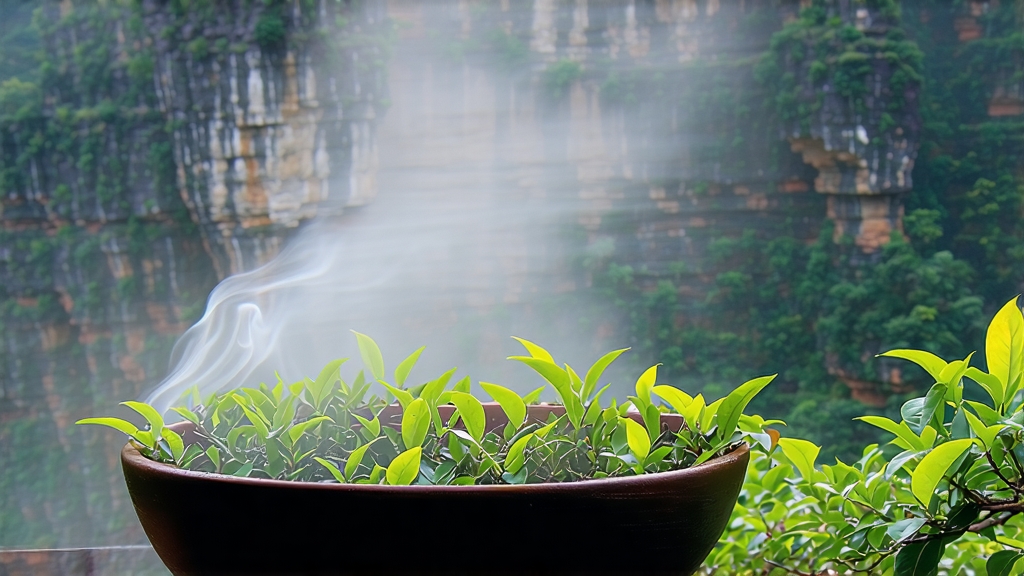
If green tea is China’s springtime whisper and pu-erh its autumnal soliloquy, then Da Hong Pao—Big Red Robe—is the mountain’s slow heartbeat, a poem carved into Wuyi’s vertical cliffs and recited in every cup for more than three centuries. To understand this oolong is to listen to stone, mist, fire, and time.
-
Origins woven with imperial crimson
Legend places the birth of Da Hong Pao in the early Qing dynasty. A Ming scholar, en route to the capital for the imperial exam, fell ill near the Wuyi range. Monks from Tianxin Temple brewed leaves plucked from six ancient bushes clinging to Jiulongke (“Nine-Dragon Nest”) cliff; the scholar revived, passed the exam, and returned in vermilion robes to drape the bushes in gratitude—hence the name. Whether apocryphal or not, the tale set the cultivar apart; by the Kangxi era (1662-1722) it was tribute tea, carried in bamboo-lined chests along the Nine-Bend River to waiting imperial barges. -
Micro-terroir: when rock breathes into leaf
UNESCO lists the 60-kilometre Wuyi gorge as a World Heritage biosphere; its Danxia landform—purple-red sandstone and weathered tuff—stores daytime heat and releases it at night, shortening the diurnal swing to a mere 5-7 °C. The gorge traps humid fog, refracting sunlight into a soft, silver diffusion that forces the tea bush to thicken cell walls, concentrating aromatic oils. Locals call this yan yun—“rock rhyme”—a mineral note that lingers like wet slate after rain. Only leaves harvested within the 60 km² core scenic zone may claim the protected designation “Zheng Yan” (true cliff); outside lies “Ban Yan” (half cliff) and still farther the plains known as “Zhou Cha,” where the rhyme thins to a hum. -
Cultivar genealogy: four brothers under one robe
Genetic fingerprinting at the Fujian Academy of Agricultural Sciences shows that today’s Da Hong Pao is not a single clone but a balanced blend of four bushes originally labeled “Qi Dan,” “Bei Dou,” “Que She,” and “Tie Luo Han.” Growers propagate them asexually through cuttings to preserve polyphenol ratios. Each bush type contributes: Qi Dan supplies orchid fragrance, Bei Dou adds peppery spark, Que She brings honeyed body, while Tie Luo Han dons the long, warming finish. Modern “mother-tree cuttings” (cloned from the last six venerated bushes on Jiulongke, now retired from plucking since 2006) are still cultivated on narrow ledges accessible only by rope ladders—an aerial garden suspended above the ravine. -
Crafting the robe: a fifteen-hour choreography
Plucking begins at dawn when the leaf’s surface tension is taut with overnight dew. Two leaves and a bud are snapped sideways to keep the tiny “fish-tail” stipule intact. The baskets descend the cliffs on bamboo zip-lines to the village courtyard where withering starts within minutes. Leaves are alternately shaken and rested on bamboo trays for 6-8 hours; each toss bruises the edge cells, allowing enzymes to meet oxygen in a controlled semi-fermentation that stops at 30-40 %—the midpoint between green and black. The critical “kill-green” roast at 240 °C lasts 90 seconds, just enough to freeze the oxidation curve. What follows is the signature Wuyi “two-bake, one-rest” cycle: initial charcoal bake (90 °C, 2 hours), a month-long dormancy to let residual moisture migrate outward, then a second bake at 80 °C for 3 hours. Master roasters use only local hardwood charcoal from Cyclobalanopsis trees; its infra-red heat penetrates the leaf spine without scorching the surface. The final tea contains less than 3 % moisture and can age gracefully for decades, developing dried-longan sweetness and a darker robe of its own. -
Tasting the cliff: a gongfu script
Water: spring or filtered, 95-98 °C. Vessel: 100 ml Yixing zi-sha teapot seasoned only with rock oolongs. Leaf ratio: 1 g per 15 ml. Rinse: flash infusion to awaken the folds. Steep